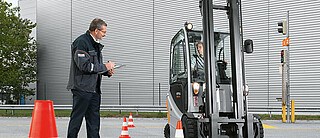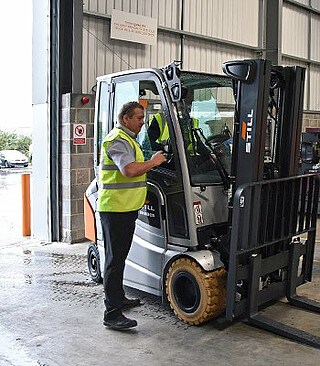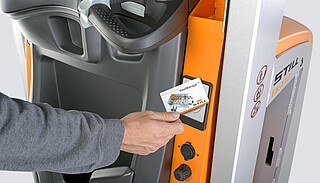How to operate a reach truck, inside a STILL forklift driver training course

The warehouse and logistic industry has been booming with the rise of eCommerce. Every £1 billion of online sales requires approximately 1.36 million square feet of warehouse space (source: Knight Frank) and those warehouses need vehicles and people qualified to operate them. Having the warehouse space and a fleet of top-of-the-range trucks is one thing, but smooth warehouse operations rely on those vehicles being run efficiently and correctly. That’s where staff training becomes essential. In this blog post, we talk to Mark Edginton, UK Head of Technical at STILL, about the importance of staff training and give a glimpse inside a STILL forklift driver training course.
What can attendees expect from a STILL forklift driver training course?
On any driver training course with STILL, candidates can expect to be given the skills they need to operate the MHE safely and efficiently, to carry out pre-use inspections and to understand the risks of truck lift and loading instabilities.
The course involves a theoretical element but there is quite a lot of practical work. Candidates get plenty of hands-on experience driving trucks. How much exactly depends on the type of training that’s given and how long it takes – for example, it could take up to 39.5 hours for a new starter to get fully accredited. There is also a written test to follow the theoretical learning and a driving test to follow the practical.
Why is it important to get staff trained to operate warehouse vehicles?
It’s really important to get people trained from a safety perspective. That’s safety for the driver, the safety of other people working in the area and avoiding damage caused to the business premises and stock. These are all important parts of making sure a driver is trained and accredited.
It’s also a legal requirement to get people trained to operate the MHE. Each type of truck is split into a separate training course. You’ve got counter-balance, reach trucks, pedestrian-powered pallet trucks (PPT), high-level PPTs, very narrow aisle (VNA) tucks, side loaders etc but they all have specific requirements for training and we offer driver training courses for each of them.

Once a vehicle operator has been trained, is there any need for further or refresher training?
There is a recommendation that refresher training is completed after three years. At the moment, this isn’t a legal requirement, but most certificates will state that, after three years, refresher training is needed and it’s absolutely something that we advise.
What makes STILL’s forklift driver training courses unique?
The biggest selling point of our training courses are our facilities. The driver training is completed at one of our two main locations (that’s Leyland and Exeter) and the trucks that are used in driver training are less than a year old and come from our demonstration fleet, so they have all the bells and whistles fitted. They’re modern, clean, well-maintained…definitely not a truck you’d be embarrassed to be driving around!
We use a third-party provider to support us in our training. They are both ITSSAR and RTITB accredited, the two main accrediting bodies in the UK, and we are able to train to both standards. We tend to use the RTITB standards rather than the ITSSAR standards, and that’s purely because the RTITB is more of an intense accreditation. By offering that, we are confident that customers leave being trained to the highest levels. We’re more than happy to accommodate an ITSSAR accreditation, but we try to use the RTITB accreditation where possible.
How does a driver training course – whether that’s initial or ongoing refresher training – benefit employers?
Coming back to an earlier point about safety, driver training gives employers piece of mind that, not only are they keeping their operators and other warehouse staff safe, but they’re ensuring that their business can continue running smoothly. Considering that forklifts may be used in areas where there are pedestrians or costly stock, it’s important to operate as safely as possible to reduce the risk of accidents or damage.
Operator efficiency is also a big benefit of training. When you take your car driving test, you’re always taught to drive with your hands at ten and two. As you get used to driving your car, those trained practices tend to slip and you always do things in a quicker, easier way. But when you take a step back and drive the way you were taught, you usually find it’s a much more effective technique. It’s the same with forklifts. Everyone picks up bad habits. The most common bad habit for a forklift operator is how to mount and dismount; how to get on the truck and get off the truck. You’re always to taught to have three points of contact when you mount and dismount but as you get used to driving a tuck many people just jump on and slide off. Sliding off always causes a problem because people will land awkwardly on their ankle and the next thing you know that operator is off sick. Refreshing taught skills always creates a better working environment for the truck operator and the people around them.
We can also work with employers to tailor our training courses to their needs. There are two types of forklift accreditations. Site-specific courses are where a candidate can be trained to drive a forklift and is issued a certificate, however if they were to leave the business that certificate wouldn’t be recognised by their new employer. Or we offer the full RTITB accreditation which is usually paid for by the employer and it’s then up to the employer to release that document to the employee should they ever leave the organisation.

How has covid-19 effected how you deliver your driver training?
Our training now has been slightly amended to facilitate covid-19 restrictions. The processes of making sure practice areas are clean and that trucks are wiped down between candidates will continue and we have restricted the number of candidates on courses so social distancing can be maintained. We were quite fortunate that we never offered training courses with large numbers of candidates – we tended to have five or six candidates at a maximum before covid-19 – so we haven’t had to make huge restrictions, but we always consider numbers to make sure that our staff and attendees are safe.
What would be your three top tips for people attending a driver training session?
Well, first off, I’d say never be afraid to ask questions. Secondly, never be restricted in observations. If you see something done that may not have been done a correct way, don’t be afraid to mention it. It may be that the operator isn’t even aware of what they’re doing. My main tip though would just be to enjoy yourself!
Find out how our professional team can help
We can help your business improve warehouse efficiency, if you need advice on any of the topics or products mentioned above, please feel free to Contact us today!
Comments
No comments
Subscribe to the blog !
Be informed as soon as an article is published. You can unsubscribe anytime.

Leave a comment